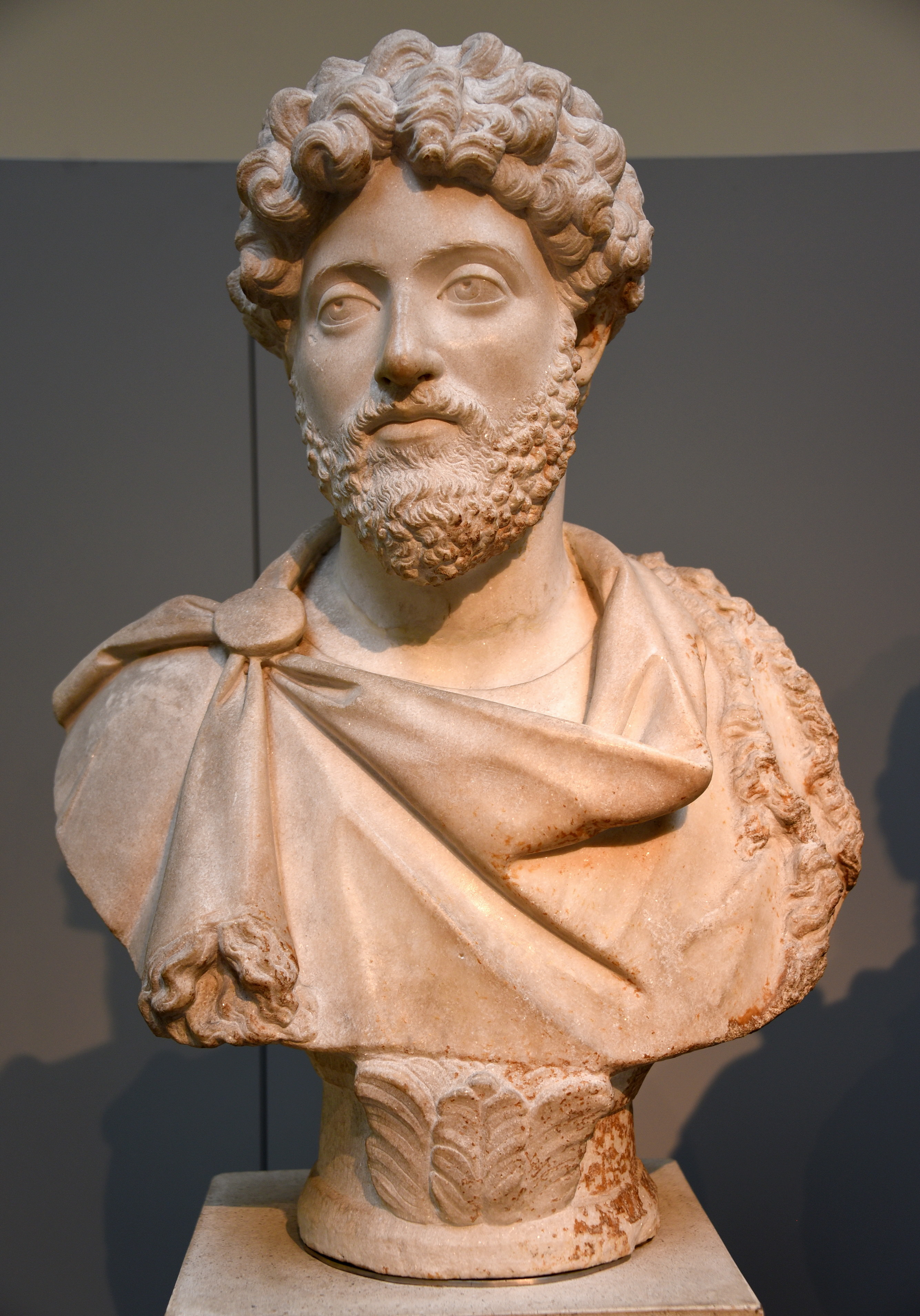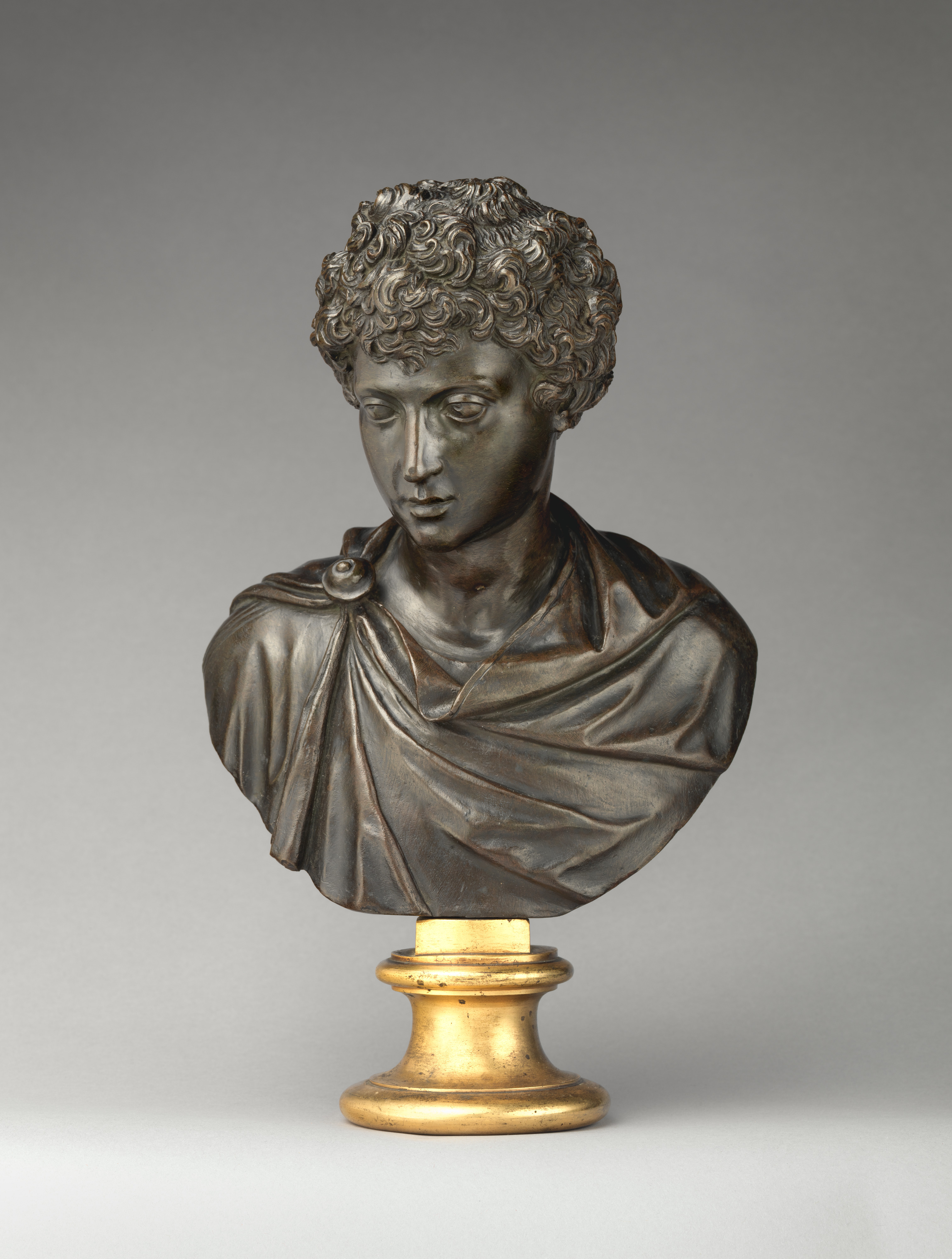Paintings Joachim Lapiak

Image result for portraits of marcus aurelius Art, Printmaking, Drawings
Aureus (Coin) Portraying Emperor Marcus Aurelius. 167 (December)-168 (December), issued by Marcus Aurelius and Lucius Verus. Roman; minted in Rome. Starting in 96 with the reign of Emperor Nerva, Rome was ruled by five wise leaders who came to be known as the "Good Emperors.". Nerva (reigned 96-98) was an honest and respected senator who.

Marcus Aurelius. Paris, Louvre Museum.
Description The statue is an over-life-size depiction of the emperor elegantly mounted atop his horse while participating in a public ritual or ceremony; the statue stands approximately 4.24 meters tall.

Colorized marble bust of Marcus Aurelius digital painting over photo of sculpture 1000x1000px
This masterful portrait of Marcus Aurelius (reigned AD 161-180) captures the pensive temperament of the philosopher-emperor and author of the celebrated "Meditations," reflections on life and the ways of the gods. The smooth, softly modeled carving of the flesh contrasts markedly with the mass of thick, curling hair.

Marcus Aurelius Marcus aurelius, Egyptian culture, Rome
1. Life and Works. Born in 121 CE and educated extensively in rhetoric and philosophy, Marcus Aurelius succeeded his adoptive father Antoninus Pius as Emperor of Rome in 161 CE and reigned until his own death in 180. His reign was troubled by attacks from Germany, rebellions in northern Italy and Egypt, and an outburst of the plague; at least.

Marcus Aurelius. Paris, Louvre Museum.
Portrait of Marcus Aurelius Roman art Characteristics Description Date Antonine age (139-152 A.D.) Museum The Uffizi Collection Sculpture Location First Corridor (A2) Technique Italic marble, perhaps Apuan Size 83.5 cm (height) Inventory 1914 n. 179

What was Marcus Aurelius’s family like? Britannica
The Column of Marcus Aurelius and Faustina which stands in Piazza Colonna in Rome is thought to have been erected by Commodus in memory of his father and mother sometime around 180 CE. The column was inspired by its more famous predecessor Trajan's Column which was set up, also in Rome, in 113 CE. The column carries representations carved in high relief of the emperor's successful military.

Marcus Aurelius at the Chicago Art Museum SculpturePorn
Aureus (Coin) Portraying Marcus Aurelius. 153-154, issued by Antoninus Pius. Roman, minted in Rome. The front (obverse) of this coin portrays a bust of Marcus Aurelius facing right, bareheaded, wearing a cuirass (body armor) and paludamentum (military cloak). The back (reverse) depicts the goddess Roma-Virtus, helmeted, standing left in.

Bust of Marcus Aurelius (Illustration) World History Encyclopedia
Known for his philosophical interests, Marcus Aurelius was one of the most respected emperors in Roman history. He was born into a wealthy and politically prominent family. Growing up,.

Head of Marcus Aurelius. Baltimore, Walters Art Museum.
October 2000 Antonine rule commenced with the reign of Antoninus Pius (r. 138-161 A.D.) and included those of Marcus Aurelius (r. 161-180 A.D.), Lucius Verus (r. 161-169 A.D.), and Commodus (r. 177-192 A.D.). Their dynasty reflects the connections between wealthy provincial and Italian families.

Bust of Marcus Aurelius at the Art Institute of Chicago r/ancientrome
This masterful portrait of Marcus Aurelius (reigned 161-180 CE) captures the pensive temperament of the philosopher-emperor and author of the celebrated "Meditations," reflections on life and the ways of the gods. The smooth, softly modeled carving of the flesh contrasts markedly with the mass of thick, curling hair.

Marcus Aurelius Italian The Metropolitan Museum of Art
The original is now indoors for purposes of conservation. Marcus Aurelius ruled 161-180 C.E.. Art historians have debated whether the portrait head most resembles the Type III or the Type IV portrait. Recent scholarly thinking, based on the work of Klaus Fittschen, holds that the equestrian portrait represents a unique variant of the.

Portrait of the Emperor Marcus Aurelius North Carolina Museum of Art
Marcus Aurelius Italian late 16th-early 17th century Not on view This admirable stone exhibits five layers. Sixteenth-century carvers often revealed the strata in concentric rings that have the effect of framing and reinforcing the images. Artwork Details Overview Signatures, Inscriptions, and Markings Provenance Exhibition History

Marcus Aurelius, 121180, Roman Emperor, Figurative World Culture GalleryWrapped Canvas Print
Marcus Aurelius (r. 161 to 180 CE) was a Roman emperor best known as the last of the Five Good Emperors of Rome (following Nerva, Trajan, Hadrian, and Antoninus Pius) and as the author of the philosophical work Meditations. Although it has been claimed he instigated a persecution of Christians, modern scholarship argues against this.

Equestrian Statue of Marcus Aurelius Watercolour World
Temple Column Statue v t e Marcus Aurelius Antoninus ( Latin: [ˈmaːrkʊs au̯ˈreːliʊs antoːˈniːnʊs]; English: / ɔːˈriːliəs / aw-REE-lee-əs; [2] 26 April 121 - 17 March 180) was Roman emperor from 161 to 180 AD and a Stoic philosopher.

Marcus Aurelius Jan de Vliegher, 2012. Belgian,b.1964 oil on canvas, 200 x 200 cm Art
In 1509, during the sessions of the Diet of Augsburg, Emperor Charles V commissioned Leone Leoni (1590-XNUMX) with a bronze equestrian sculpture that would have been the first made of a Spanish monarch. However, the temperamental artist, who had in his Milanese studio a cast of the equestrian portrait of Marcus Aurelius, did not get to model it.

Marcus Aurelius Daily Stoic
Marcus Aurelius. Marcus Aurelius (121 - 180), also called a Philosopher, was Roman emperor from 161 to 180. He was the last of the Roman rulers traditionally known as the Five Good Emperors. He is also seen as the last emperor of the Pax Romana, an age of relative peace and stability for the Empire. His philosophical writings, now commonly.